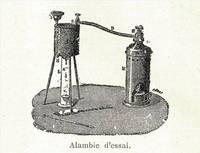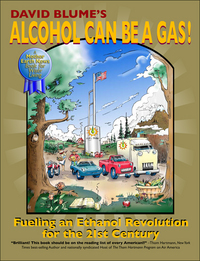ETHANOL Helps America Become a Nation of Alcoholics - Alcohol and Driving DO Mix
 |
Helping America Become a Nation of Alcoholics (but not in a MADD way)
SEE ALSO
SEE ALSO: Ethanol Content Library - 2020-1996SEE ALSO: The Ethanol Papers By Marc Rauch(640 Page Book)
SEE ALSO: TRUTH ABOUT ETHANOL - Book Review and Reply to Robert Bryce's GUSHER OF LIES
SEE ALSO: The Auto Channel Fights for the Truth about Ethanol Versus Gasoline
SEE ALSO: Ed Begley, Jr, Converts Prius to use Ethanol and Ethanol Booster (Road Trip VIDEO)
SEE ALSO: Exclusive Audio of Feb 3, 2010 Conference Call U.S. Energy Bio-fuel Task Force
SEE ALSO: Princeton BioEthanol Tutorial
SEE ALSO: Gasoline, America's Problem - Ethanol, American Solution
SEE ALSO: Electric Vehicles-Solution or Diversion?
SEE ALSO: Big Oil Benefits From "Divide and Conquer"
By Bob Gordon
President and Co-publisher
The Auto Channel
AUTO CENTRAL - October 4, 2009: Last week Marc Rauch, my friend, business partner and co-founder of The Auto Channel, traveled down to LA from his home in Northern California to interview and visit with Ed Begley Jr., an actor who is VERY involved with the future of our world, and David Blume author of a book titled Alcohol Can Be A Gas.
As many of our readers know, both Marc and I are very concerned about how damaging gasoline has been and will continue to be to our country's air, economy and future unless we do something about it. We have both been on the edge when it comes to understanding and reporting on alt fuel vehicles and putting our thoughts where our audience is (thank you).
After discussing Marc's trip and what it meant, and reviewing my exciting ethanol meetings these past few weeks, it all came together for me.
During the past 10 years or so, members of the alt fuel crowd have held various stature levels among the general population, based on the cost of gasoline at that moment.
Although each fuel's advocate also promoted a common vision of a "No Gasoline Future", each has a different and sometimes conflicting solution, in fact there are so many "solutions" that it became obvious to me that this plethora of ideas is counter-productive and is accomplishing exactly what the promoters of the status-quo want...lots of talk, more and more studies with little or no actions that would reduce oil company profits or their domination of our country's transportation and foreign policy.
To that end, on May 9, 2006, The Auto Channel published an editorial titled "Big Oil Benefits From "Divide and Conquer" which included this observation; More than 2,500 years ago, Sun Tzu wrote in a book called “The Art of War”, that success will come from the strategy of “divide and conquer”: a strategy that is at work today in our efforts to solve our nation's and the world’s Junkie Like Dependence on fossil fuels and the companies and countries that sell us the needed “smack”.
No, we here at The Auto Channel are not tree hungers (why is that a bad thing?) or do-gooders or teeny tiny car promoters, we are car guys who believe it's not the size of a car that should matter, but what that vehicle uses as fuel. We want the generations that come after us to have a choice of size and power in their vehicle... In, fact back in May we published "Cars with Choice of Fuel, Not Small Cars Without Choice, Is What's Good for America" hey America is a big country with big people with large vehicle needs, so why shouldn't we have them?
Now here we are three years after our 2006 "Divide and Conquer" editorial, still blinded by the light of so many choices; Hydrogen, Electric, Compressed Air, CNG, Methane, Diesel, Hybrids, etc., albeit good choices, in fact so credible are those choices that what is, and should be our number one solution has been allowed to be mishandled, mismanaged and bad mouthed to death by the status quo'ers who are gleefully raking in the profits while our country sinks deeper into a morass of bad air and a crappy economy that is played like a puppet by the oil guys...enough is enough!
A quick easy, inexpensive and (very) local solution to our country’s 100 year addiction to oil-based fuel for transportation has been right in front of our faces all this time: alcohol.
Alcohol, not an exotic rocket science solution, a fuel for Internal Combustion Engines that is “so easy to “make that even a cave man can do it” (and did do it eons ago). A fuel that may end up the manna of our time, put here by nature for man's use and gathering …
Alcohol fuel made from switch grass, algae, garbage, or every cellulosic material will help us quickly, inexpensively, sustainably, economically, democratically and ubiquitously… kick the gasoline habit that we now have to power our personal transportation.
A few weeks ago I was invited to attend a meeting of the Ohio BioSystems Cooperative, Inc. a not-for-profit Research and Development entity based in rural northeastern Ohio.
The meeting was a sit down old fashioned “let’s solve this problem get together” of Americans of different stripes, yet Americans nonetheless… a meeting that brought together the assets to convince other Americans that our sending billions of dollars to guys who want us to treat our wives and daughters as chattel, and want everyone to observe Sharia law, in countries where freedom is non-existent and where the powers that be have nurtured a sub-specie of humans who believe that it is okay to murder, maim and destroy in the name of their “peace loving” religion.
The meeting was chaired by a true patriot, Ted Chipner, ex-military, car guy and top of his classer, who for the past few years has dedicated himself to try and bring sanity back to our country… and frankly has been having a rough time of it… so this meeting was to be the first step in changing all that.
Attending the meeting held at beautiful Ashland University were bankers, truckers, farmers, politicians, economic development executives, equipment manufacturers, students, journalists, educators and others interested in getting this fuel thing straightened out after 100 years of poisoning the air and our foreign policy.
But the net net of this whole thing can be summed up in the following simple points that reinforce the notion that “Alcohol and Driving Do Mix”
1. Alcohol (Ethanol) has been used as a fuel for Internal Combustion Engines for more than 100 years.
2. Alcohol can be manufactured in every village, town and city in the United States
3. Alcohol can be made from non-food plants and every other organic stuff
4. Alcohol can be made from switch grass, planted, grown and harvested by American farmers who will utilize second rate farmland for first rate profits.
5. Local governments can facilitate the production of alcohol by local citizens redirecting the billions of dollars that everybody in the U.S. is already spending on gasoline…this scheme will allow poison money to be invested in all of ourown local communities with benefits going to America.
6. Existing closed or underutilized ethanol factories can be bought by a group of counties and soon become America’s oil fields
7. Alcohol will be manufactured by local farm co-ops and local grass roots government directed business for less than 50 cent per gallon
8. Local ethanol can be sold by these co-ops to area residents at $1.50 per gallon with a dollar a gallon going to the local highway and general funds.
9. Today 190 million EFI on the road vehicles here in the U.S. can be easily and economically converted to use alcohol instead of gasoline.
10. Tomorrow; building new flex fuel cars will cost manufactures less than $100 per car. (Ed Note: During the 2010 Detroit Auto Show The Auto Channel was told that 50% of all 2012 GM models will be Flex-Fuel Badged...we need to make lots of E-85 now)
11. Alcohol is better for cars than gasoline; it burns cleaner so engines that use it can last much longer with less maintenance than cars that burn gasoline.12. Future Vision; there is technology in place that will allow vehicles to fill up on ethanol and have it converted on the fly into hydrogen for future Fuel Cell Electric Vehicles.
13. So What’s The Problem Here?
The concepts above have been proofed against existing stories on The Auto Channel and other publications that care more about our country’s future than on ruffling oil company feathers…
Why Alcohol Fuel? The Two-Minute Summary
- Almost every country can become energy independent. Anywhere that has sunlight and land can produce alcohol from plants. Brazil, the fifth largest country in the world imports no oil, since half its cars run on alcohol fuel made from sugarcane, grown on 1% of its land.
- We can reverse global warming. Since alcohol is made from plants, its production takes carbon dioxide out of the air, sequestering it, with the result that it reverses the greenhouse effect (while potentially vastly improving the soil). Recent studies show that in a permaculturally designed mixed-crop alcohol fuel production system, the amount of greenhouse gases removed from the atmosphere by plants—and then exuded by plant roots into the soil as sugar—can be 13 times what is emitted by processing the crops and burning the alcohol in our cars.
- We can revitalize the economy instead of suffering through Peak Oil. Oil is running out, and what we replace it with will make a big difference in our environment and economy. Alcohol fuel production and use is clean and environmentally sustainable, and will revitalize families, farms, towns, cities, industries, as well as the environment. A national switch to alcohol fuel would provide many millions of new permanent jobs.
- No new technological breakthroughs are needed. We can make alcohol fuel out of what we have, where we are. Alcohol fuel can efficiently be made out of many things, from waste products like stale donuts, grass clippings, food processing waste-even ocean kelp. Many crops produce many times more alcohol per acre than corn, using arid, marshy, or even marginal land in addition to farmland. Just our lawn clippings could replace a third of the autofuel we get from the Mideast.
- Unlike hydrogen fuel cells, we can easily use alcohol fuel in the vehicles we already own. Unmodified cars can run on 50% alcohol, and converting to 100% alcohol or flexible fueling (both alcohol and gas) costs only a few hundred dollars. Most auto companies already sell new dual-fuel vehicles.
- Alcohol is a superior fuel to gasoline! It’s 105 octane, burns much cooler with less vibration, is less flammable in case of accident, is 98% pollution-free, has lower evaporative emissions, and deposits no carbon in the engine or oil, resulting in a tripling of engine life. Specialized alcohol engines can get at least 22% better mileage than gasoline or diesel.
- It’s not just for gasoline cars. We can also easily use alcohol fuel to power diesel engines, trains, aircraft, small utility engines, generators to make electricity, heaters for our homes—and it can even be used to cook our food.
- Alcohol has a proud history. Gasoline is a refinery’s toxic waste; alcohol fuel is liquid sunshine. Henry Ford’s early cars were all flex-fuel. It wasn’t until gasoline magnate John D. Rockefeller funded Prohibition that alcohol fuel companies were driven out of business.
- The byproducts of alcohol production are clean, instead of being oil refinery waste, and are worth more than the alcohol itself. In fact, they can make petrochemical fertilizers and herbicides obsolete. The alcohol production process concentrates and makes more digestible all protein and non-starch nutrients in the crop. It’s so nutritious that when used as animal feed, it produces more meat or milk than the corn it comes from. That’s right, fermentation of corn increases the food supply and lowers the cost of food.
- Locally produced ethanol supercharges regional economies. Instead of fuel expenditures draining capital away to foreign bank accounts, each gallon of alcohol produces local income that gets recirculated many times. Every dollar of tax credit for alcohol generates up to $6 in new tax revenues from the increased local business.
- Alcohol production brings many new small-scale business opportunities. There is huge potential for profitable local, integrated, small-scale businesses that produce alcohol and related byproducts, whereas when gas was cheap, alcohol plants had to be huge to make a profit.
- Scale matters—most of the widely publicized potential problems with ethanol are a function of scale. Once production plants get beyond a certain size and are too far away from the crops that supply them, closing the ecological loop becomes problematic. Smaller-scale operations can more efficiently use a wide variety of crops than huge specialized one-crop plants, and diversification of crops would largely eliminate the problems of monoculture.
- The byproducts of small-scale alcohol plants can be used in profitable, energy-efficient, and environmentally positive ways. For instance, spent mash (the liquid left over after distillation) contains all the nutrients the next fuel crop needs and can return it back to the soil if the fields are close to the operation. Big-scale plants, because they bring in crops from up to 45 miles away, can’t do this, so they have to evaporate all the water and sell the resulting byproduct as low-price animal feed,which accounts for half the energy used in the plant.
|
|
Much of the increased interest in ethanol as a vehicle fuel is due to its ability to replace gasoline from imported oil. The United States is currently the world's largest ethanol producer, and most of the ethanol we use is produced domestically from corn grown by American farmers.
E85 also provides important reductions in greenhouse gas (GHG) emissions. When made from corn, E85 reduces lifecycle GHG emissions (which include the energy required to grow and process corn into ethanol) by 15-20% as compared to gasoline. E85 made from cellulose can reduce emissions by around 70 percent as compared to gasoline.
EPA's stringent Tier II vehicle emission standards require that FFVs achieve the same low emissions level regardless of whether E85 or gasoline is used. However, E85 can further reduce emissions of certain pollutants as compared to conventional gasoline or lower volume ethanol blends. For example, E85 is less volatile than gasoline or low volume ethanol blends, which results in fewer evaporative emissions. Using E85 also reduces carbon monoxide emissions and provides significant reductions in emissions of many harmful toxics, including benzene, a known human carcinogen. However, E85 also increases emissions of acetaldehyde--a toxic pollutant. EPA is conducting additional analysis to expand our understanding of the emissions impacts of E85.




